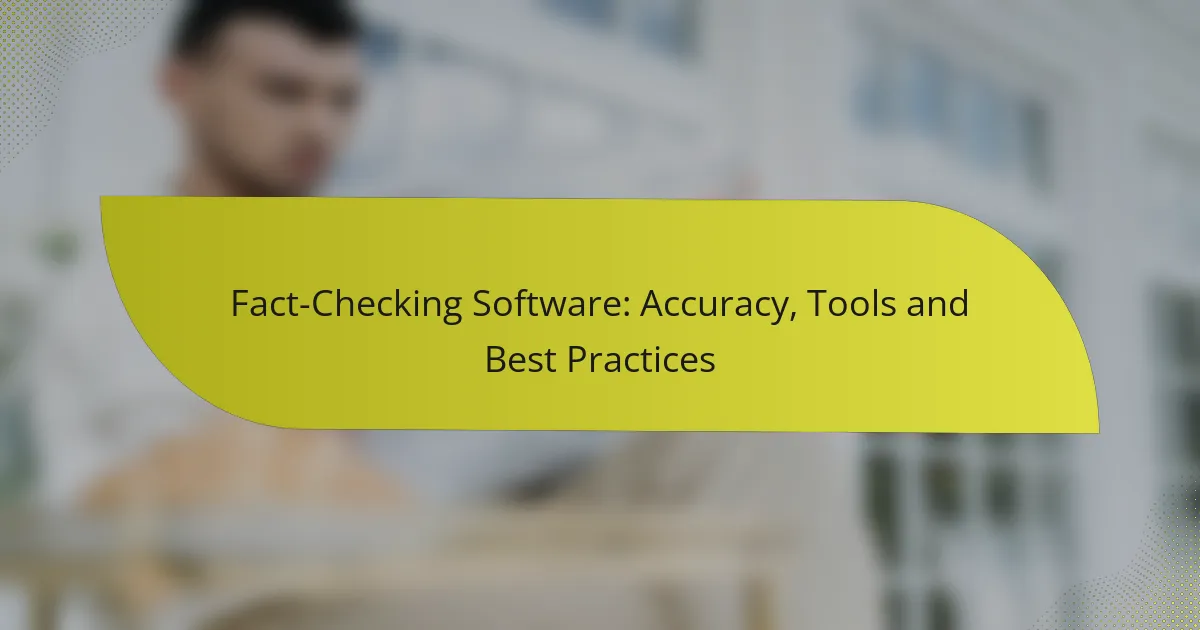Fact-checking software plays a crucial role in verifying the accuracy of information in today’s fast-paced digital landscape. By automating the verification process, these tools enable users to efficiently assess the validity of claims while minimizing errors. Selecting the right software involves considering features that enhance usability, access to comprehensive databases, and collaboration capabilities.
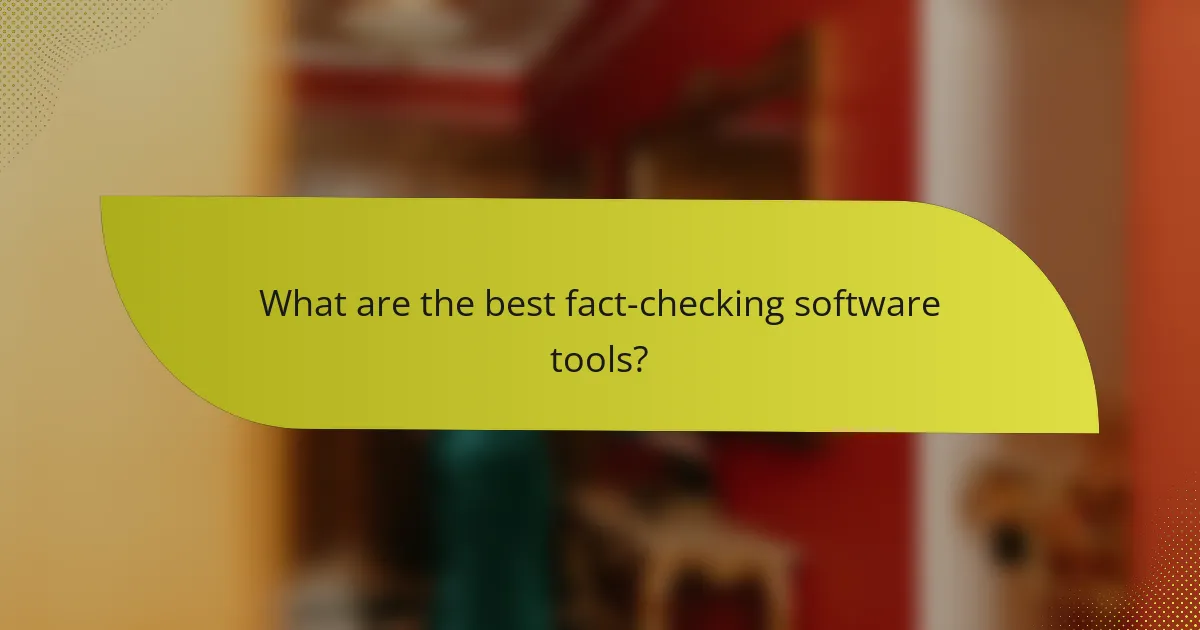
What are the best fact-checking software tools?
The best fact-checking software tools are designed to help users verify the accuracy of information quickly and efficiently. These tools vary in features, usability, and focus areas, making it essential to choose one that fits your specific needs.
FactCheck.org
FactCheck.org is a non-profit organization that monitors the factual accuracy of statements made by politicians and public figures. It provides detailed analyses and sources for its claims, making it a reliable resource for checking political statements and campaign ads.
This tool is particularly useful for journalists and researchers who need to verify claims in real-time. Users can search for specific topics or browse recent fact checks to stay informed on current issues.
Snopes
Snopes is one of the oldest and most well-known fact-checking websites, focusing on urban legends, rumors, and misinformation. It provides comprehensive investigations into viral claims, often breaking down the evidence and sources behind each story.
For effective use, users can search by keywords or categories, making it easy to find information on specific topics. Snopes is particularly valuable for debunking myths and false information circulating on social media platforms.
PolitiFact
PolitiFact specializes in fact-checking political statements and promises, using a “Truth-O-Meter” to rate the accuracy of claims. This tool is particularly beneficial for voters who want to assess the credibility of candidates and their statements during election cycles.
PolitiFact’s ratings range from “True” to “Pants on Fire,” providing a clear visual representation of the accuracy of claims. Users can explore specific politicians or issues, making it a targeted resource for political fact-checking.
ClaimBuster
ClaimBuster is an automated fact-checking tool that uses natural language processing to identify factual claims in text. It is designed to assist journalists by flagging statements that may require verification, streamlining the fact-checking process.
This tool is particularly useful for analyzing speeches, articles, and social media posts. Users can benefit from its ability to quickly highlight claims, allowing for more efficient research and verification.
Full Fact
Full Fact is a UK-based independent fact-checking organization that focuses on verifying claims made in public discourse. It covers a wide range of topics, from politics to health, and provides detailed reports on the accuracy of various statements.
Users can access a database of fact checks and use tools to submit claims for verification. Full Fact is especially relevant for those in the UK looking to navigate misinformation in public discussions and media.
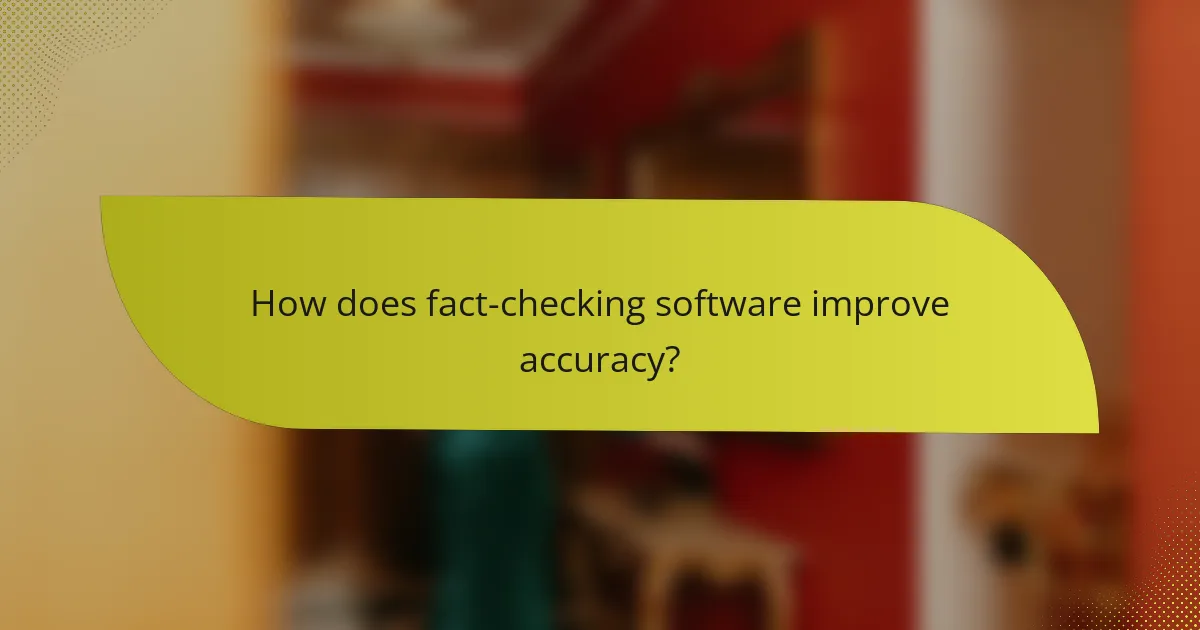
How does fact-checking software improve accuracy?
Fact-checking software enhances accuracy by automating the verification process, allowing users to quickly assess the validity of claims. These tools utilize algorithms and databases to cross-reference information, reducing the likelihood of errors in reporting.
Reduces misinformation
Fact-checking software plays a crucial role in reducing misinformation by identifying false claims and providing reliable sources for verification. By analyzing large volumes of data, these tools can flag inaccuracies in real-time, helping users make informed decisions based on factual information.
For example, during a news event, fact-checking software can instantly verify statements made by public figures against established facts, thus curbing the spread of false narratives. This proactive approach is essential in maintaining the integrity of information in today’s fast-paced media landscape.
Enhances credibility
Using fact-checking software enhances the credibility of content by ensuring that all claims are substantiated with accurate data. When organizations consistently verify their information, they build trust with their audience, which is vital for maintaining a loyal readership.
For instance, a news outlet that regularly employs fact-checking tools is more likely to be viewed as a reliable source compared to one that does not. This credibility can lead to increased audience engagement and a stronger reputation in the industry.
Streamlines research
Fact-checking software streamlines the research process by providing quick access to verified information and relevant sources. This efficiency allows users to focus on content creation rather than spending excessive time on manual verification.
Tools often include features like citation tracking and source comparison, which can significantly reduce the time spent on research tasks. By integrating these tools into their workflow, researchers and journalists can enhance productivity and ensure the accuracy of their work.
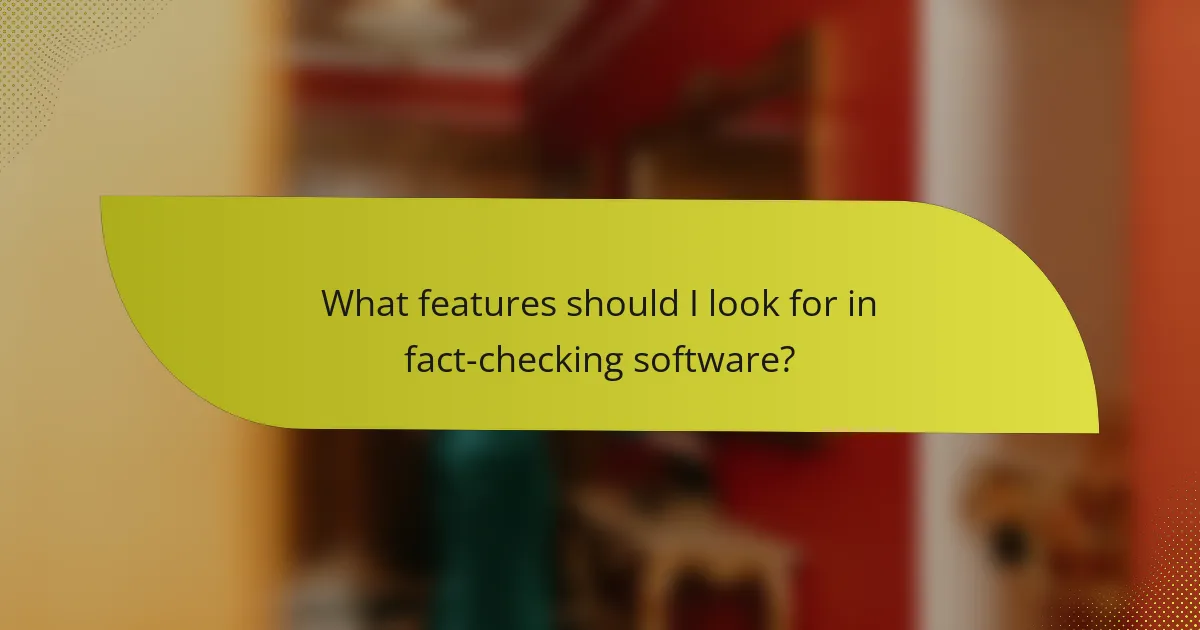
What features should I look for in fact-checking software?
When selecting fact-checking software, prioritize features that enhance accuracy, usability, and collaboration. Key aspects include a user-friendly interface, access to a comprehensive database, real-time updates, and tools that facilitate teamwork.
User-friendly interface
A user-friendly interface is essential for efficient fact-checking. It should allow users to navigate easily, with intuitive design elements that minimize the learning curve. Look for software that offers customizable dashboards and clear labeling of functions.
Consider tools that provide tutorials or help sections, as these can significantly enhance user experience. A well-designed interface can save time and reduce errors, making the fact-checking process more effective.
Comprehensive database
A comprehensive database is crucial for reliable fact-checking. The software should access a wide range of sources, including academic articles, news outlets, and verified databases. This breadth ensures that users can cross-reference information effectively.
Check if the software includes filters or search functionalities to help locate specific types of information quickly. A robust database can significantly improve the accuracy of the fact-checking process by providing diverse perspectives and data points.
Real-time updates
Real-time updates are vital for keeping information current and relevant. Fact-checking software should automatically refresh its data to reflect the latest developments and corrections. This feature is particularly important in fast-paced news environments.
Look for tools that notify users of significant changes or updates in the data sources they monitor. Staying updated minimizes the risk of relying on outdated or incorrect information, enhancing the overall credibility of the fact-checking efforts.
Collaboration tools
Collaboration tools facilitate teamwork among fact-checkers, allowing multiple users to work on projects simultaneously. Features like shared workspaces, comment sections, and task assignments can streamline the fact-checking process.
Evaluate whether the software supports integration with communication platforms, as this can enhance coordination among team members. Effective collaboration tools can lead to more thorough fact-checking and quicker turnaround times on projects.

How do I choose the right fact-checking software for my needs?
Choosing the right fact-checking software involves understanding your specific requirements, comparing available options, and evaluating user experiences. Focus on features that align with your goals, such as accuracy, ease of use, and integration capabilities.
Assess user requirements
Start by identifying what you need from a fact-checking tool. Consider factors like the types of content you will be verifying, the volume of checks required, and whether you need real-time results or batch processing. For instance, journalists may prioritize speed and accuracy, while researchers might focus on comprehensive databases.
Additionally, think about the user interface and whether the software can integrate with your existing systems. A user-friendly interface can significantly enhance productivity, while integration with content management systems can streamline your workflow.
Compare pricing plans
Fact-checking software comes in various pricing structures, from free tools to subscription-based services. Evaluate what features are included in each pricing tier and whether they meet your needs. Some platforms may offer basic functionalities for free but charge for advanced features.
Consider your budget and how much you are willing to invest. Subscription costs can range from low monthly fees to higher annual payments, so it’s essential to weigh the benefits against the costs. Look for trials or demos to test the software before committing financially.
Read user reviews
User reviews provide valuable insights into the effectiveness and reliability of fact-checking software. Check platforms like G2 or Capterra to see what other users are saying about their experiences. Look for comments on accuracy, customer support, and ease of use.
Pay attention to both positive and negative feedback to get a balanced view. Common pitfalls mentioned in reviews can help you avoid making a poor choice. Additionally, consider reaching out to peers in your industry for recommendations based on their experiences with different tools.
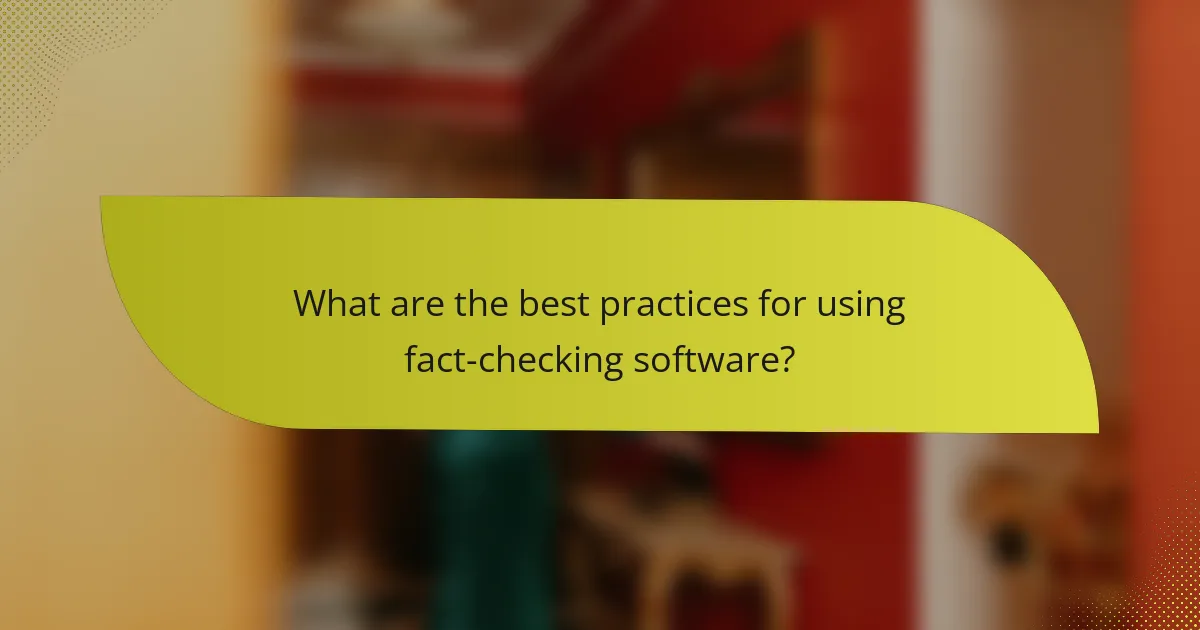
What are the best practices for using fact-checking software?
To effectively use fact-checking software, it is essential to implement best practices that enhance accuracy and reliability. This includes keeping the software updated, cross-referencing multiple sources, and ensuring that team members are well-trained in its use.
Regular updates
Regular updates to fact-checking software are crucial for maintaining its accuracy and effectiveness. Software developers frequently release updates that improve algorithms, fix bugs, and incorporate new data sources. Failing to update can result in outdated information and reduced reliability.
Set a schedule for updates, ideally monthly or quarterly, to ensure that your software reflects the latest information and standards. Additionally, subscribe to notifications from the software provider to stay informed about critical updates.
Cross-reference sources
Cross-referencing sources is a vital practice in fact-checking to confirm the accuracy of information. Relying on a single source can lead to misinformation, so it is advisable to consult multiple reputable sources before drawing conclusions.
Utilize a mix of primary and secondary sources, such as academic journals, government publications, and established news outlets. Create a checklist of trusted sources to streamline the cross-referencing process and ensure comprehensive verification.
Train team members
Training team members on how to effectively use fact-checking software is essential for maximizing its potential. Proper training ensures that users understand the software’s features and can leverage them to verify information accurately.
Conduct regular training sessions that cover software functionalities, best practices, and common pitfalls. Encourage team members to share their experiences and insights to foster a culture of continuous learning and improvement in fact-checking processes.

What are the common challenges in fact-checking?
Fact-checking faces several challenges that can hinder accuracy and efficiency. These include the sheer volume of information, the speed at which news spreads, and the complexity of verifying sources and claims.
Volume of Information
The vast amount of information available online makes it difficult for fact-checkers to sift through data effectively. With millions of articles, social media posts, and reports published daily, identifying credible sources can be overwhelming.
To manage this, fact-checkers should prioritize high-impact claims and focus on trending topics. Utilizing automated tools can help filter relevant information, but human oversight remains crucial to ensure context and nuance are considered.
Speed of Information Dissemination
The rapid spread of information, especially on social media, poses a significant challenge for fact-checking. Misinformation can go viral within minutes, making it essential for fact-checkers to act quickly to correct false claims.
Establishing a streamlined process for rapid verification is vital. This may involve setting up alerts for trending topics and using collaborative platforms to share findings with other fact-checkers swiftly.
Complexity of Verifying Sources
Verifying the credibility of sources is a complex task that requires critical analysis. Many claims are based on anecdotal evidence or unverified reports, making it challenging to ascertain their accuracy.
Fact-checkers should develop a checklist for evaluating sources, including checking the author’s credentials, the publication’s reputation, and the presence of supporting evidence. This systematic approach can help mitigate the risks of relying on dubious information.
